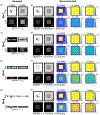Model-constrained reconstruction accelerated with Fourier-based undersampling for hyperpolarized [1-13 C] pyruvate imaging
- PMID: 36468638
- PMCID: PMC9892212
- DOI: 10.1002/mrm.29551
Model-constrained reconstruction accelerated with Fourier-based undersampling for hyperpolarized [1-13 C] pyruvate imaging
Abstract
Purpose: Model-constrained reconstruction with Fourier-based undersampling (MoReFUn) is introduced to accelerate the acquisition of dynamic MRI using hyperpolarized [1-13 C]-pyruvate.
Methods: The MoReFUn method resolves spatial aliasing using constraints introduced by a pharmacokinetic model that describes the signal evolution of both pyruvate and lactate. Acceleration was evaluated on three single-channel data sets: a numerical digital phantom that is used to validate the accuracy of reconstruction and model parameter restoration under various SNR and undersampling ratios, prospectively and retrospectively sampled data of an in vitro dynamic multispectral phantom, and retrospectively undersampled imaging data from a prostate cancer patient to test the fidelity of reconstructed metabolite time series.
Results: All three data sets showed successful reconstruction using MoReFUn. In simulation and retrospective phantom data, the restored time series of pyruvate and lactate maintained the image details, and the mean square residual error of the accelerated reconstruction increased only slightly (< 10%) at a reduction factor up to 8. In prostate data, the quantitative estimation of the conversion-rate constant of pyruvate to lactate was achieved with high accuracy of less than 10% error at a reduction factor of 2 compared with the conversion rate derived from unaccelerated data.
Conclusion: The MoReFUn technique can be used as an effective and reliable imaging acceleration method for metabolic imaging using hyperpolarized [1-13 C]-pyruvate.
Keywords: constrained reconstruction; hyperpolarized MR; pharmacokinetic modeling; pyruvate; undersampling.
© 2022 International Society for Magnetic Resonance in Medicine.
Figures










